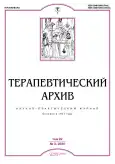Evaluation of the relationship between the parameters of peripheral skeletal and respiratory muscles in patients with chronic obstructive pulmonary disease
- Authors: Suleymanova A.K.1, Baranova I.A.1
-
Affiliations:
- Pirogov Russian National Research Medical University
- Issue: Vol 92, No 3 (2020)
- Pages: 36-41
- Section: Editorial article
- URL: https://journals.rcsi.science/0040-3660/article/view/33893
- DOI: https://doi.org/10.26442/00403660.2020.03.000448
- ID: 33893
Cite item
Full Text
Abstract
Chronic obstructive pulmonary disease (COPD) is a group of diseases with high levels of comorbidity. Pathological changes of peripheral skeletal and respiratory muscles in COPD patients, which are often underestimated, occupy a special place.
Aim. To study the relationship between functional and quantitative parameters of the peripheral (limb muscle) and respiratory muscles in COPD patients.
Materials and methods. 127 patients (98 men/29 women, mean age 67.6±8.2 years) were under observation without acute COPD. All COPD patients were classified according to GOLD (2019) into groups A, B, C, D. The algorithm of the European Working Group on Sarcopenia in Older People (EWGSOP2) was used to diagnose sarcopenia. The muscle mass was measured using dual energy X-ray absorptiometry (DXA) and the appendicular lean mass index (ASM) was estimated. Maximal inspiratory pressure (MIP) and maximal expiratory pressure (MEP) were measured by body plethysmograph MasterScreen Body. Quantitative assessment of thoracic muscle cross-sectional areas were performed using the CT scan using Vidar Dicom Viewer software.
Results. Sarcopenia was diagnosed in 43.3% of COPD patients. Respiratory muscle dysfunction was determined in 66.1% of patients with COPD, its probability increased in groups C and D in comparison with groups A and B [chance ratio 6.6 (95% confidence interval 2.9–15.0); p<0.0001]. Correlations between the functional parameters of sarcopenia and respiratory muscle strength as well as between the mass of peripheral skeletal muscles and respiratory muscle area have been established according to the data of computerized tomography (р<0.01). Sarcopenia as well as respiratory muscle dysfunction was observed more frequently in persons with severe and extremely severe airway obstruction and in patients with predominantly emphysematic COPD phenotype (p<0.01).
Conclusion. Sarcopenia is a frequent comorbidity in COPD and its development is connected with the severity of the course of the main disease. Correlation between parameters of peripheral (limb muscle) and respiratory muscles in patients with COPD has been determined.
Keywords
Full Text
##article.viewOnOriginalSite##About the authors
A. K. Suleymanova
Pirogov Russian National Research Medical University
Author for correspondence.
Email: angelina.suleymanova91@gmail.com
ORCID iD: 0000-0002-2387-0370
аспирант и ассистент каф. госпитальной терапии педиатрического фак-та.
Russian Federation, MoscowI. A. Baranova
Pirogov Russian National Research Medical University
Email: angelina.suleymanova91@gmail.com
д.м.н., проф., проф. каф. госпитальной терапии педиатрического фак-та
Russian Federation, MoscowReferences
- Global strategy for the diagnosis, management, and prevention of Chronic Obstructive Pulmonary Disease (GOLD 2019); http://goldcopd.org
- Alfonso J Cruz-Jentoft, Gülistan Bahat, et al. Writing Group for the European Working Group on Sarcopenia in Older People 2 (EWGSOP2), and the Extended Group for EWGSOP2; Sarcopenia: revised European consensus on definition and diagnosis. Age and Ageing. 2018;169. doi: 10.1093/ageing/afy169
- Enright PL, Kronmal RA, Manolio TA, et al. Respiratory muscle strength in the elderly. Correlates and reference values. Cardiovascular health study research group. Am J Respir Crit Care Med. 1994;149:430-8. doi: 10.1164/ajrccm.149.2.8306041
- Wilson SH, Cooke NT, Edwards RH, et al. Predicted normal values for maximal respiratory pressures in caucasian adults and children. Thorax. 1984;39(7):535–8. doi: 10.1136/thx.39.7.535.
- Rozenberg D, Singer LG, Mendes P, et al. Association of Thoracic Muscle Cross-Sectional Area and Clinical Outcomes in Lung Transplant Candidates. J Heart Lung Transplant. 2015;34:S15-6. doi: 10.1016/j.healun.2015.01.029
- Barreiro E, Jaitovich A. Muscle atrophy in chronic obstructive pulmonary disease: molecular basis and potential therapeutic targets. J Thorac Dis. 2018;10(12):1415-24. doi: 10.21037/jtd.2018.04.168
- Ischaki E, Papatheodorou G, Gaki E, et al. Body mass and fat-free mass indices in COPD: relation with variables expressing disease severity. Chest. 2007;132:164-9. doi: 10.1378/chest.06-2789
- Schols AM, Broekhuizen R, Weling-Scheepers CA, et al. Body composition and mortality in chronic obstructive pulmonary disease. Am J Clin Nutr. 2005;82:53-9. doi: 10.,1093/ajcn.82.1.53
- American Thoracic Society/European Respiratory Society: ATS/ERS statement on respiratory muscle testing. Am J Respir Crit Care Med. 2002;166:518-624. doi: 10.1164/rccm.166.4.518
- Black L, Hyatt R. Maximal Respiratory Pressures: Normal Values and Relationship to Age and Sex. Am Rev Respir Dis. 1969;99:696. doi: 10.1164/arrd.1969.99.5.696
- Goodpaster BH, Thaete FL, Kelley DE. Composition of skeletal muscle evaluated with computed tomography. Ann N Y Acad Sci. 2000;904:18. doi: 10.1111/j.1749-6632.2000.tb06416.x
- Shen W, Punyanitya M, Wang Z, et al. Total body skeletal muscle and adipose tissue volumes: estimation from a single abdominal cross-sectional image. J Appl Physiol. 2004;97:2333. doi: 10.1152/japplphysiol. 00744.2004
- McDonald ML, Diaz AA, Ross JC, et al. Quantitative computed tomography measures of pectoralis muscle area and disease severity in chronic obstructive pulmonary disease. A cross-sectional study. Ann Am Thorac Soc. 2014;11:326. doi: 10.1513/AnnalsATS.201307-229OC
- Tanimura K, Sato S, Fuseya Y, et al. Quantitative assessment of erector spinae muscles in patients with chronic obstructive pulmonary disease. Novel chest computed tomography-derived index for prognosis. Ann Am Thorac Soc. 2016;13:334. doi: 10.1513/AnnalsATS.201507-446OC
Supplementary files







